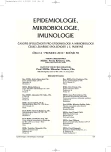Surveillance of invasive meningococcal disease and recommended vaccination against meningococcal infections in the Czech Republic
Authors:
P. Křížová
; M. Musílek
Authors‘ workplace:
Národní referenční laboratoř pro meningokokové nákazy, Státní zdravotní ústav, Praha
Published in:
Epidemiol. Mikrobiol. Imunol. 59, 2010, č. 4, s. 173-182
Overview
The nationwide surveillance of invasive meningococcal disease in the Czech Republic has been conducted since 1993 by the National Reference Laboratory (NRL) for Meningococcal Infections in close cooperation with epidemiologists, microbiologists and clinicians. NRL has been involved in national and international research projects and networks and performs molecular characterization of Neisseria meningitidis that is helpful in both national and international surveillance of invasive meningococcal disease, provides background information for vaccination strategy updates and contributes to the development of novel meningococcal vaccines. Two noteworthy events occurred in 2010: a worldwide recommendation was issued on a booster conjugate vaccine dose and conjugate tetravaccine A,C,Y,W135 was registered for use in Europe. According to the latest recommendations of the world experts, the first dose of conjugate vaccine should be given in childhood and should be followed by a booster dose at the pre-adolescent age. The recommended booster is conjugate tetravaccine A,C,Y,W135 that provides long-term broad immunity and should also be available in the Czech Republic as soon as possible. It is necessary to keep up to date with the development of novel vaccines against meningococcal infections caused by serogroup B (MenB) and to test them for suitability for use in the Czech Republic. As soon as such a MenB vaccine is developed and registered, it will be desirable to include it into the routine childhood immunization scheme in the Czech Republic because of the high incidence of Meningococcus B infections in the youngest age group.
Key words:
surveillance of invasive meningococcal disease – meningococcal vaccine – vaccination strategy.
Sources
1. Raska, K. National and international surveillance of communicable diseases. WHO Chron., 1966, 20, 9, p. 315–321.
2. Raska, K. Epidemiologic surveillance in the control of infectious disease. Rev. Infect. Dis., 1983, 5, 6, p. 1112–1117.
3. Věstník MZ ČR: Metodický návod k epidemiologickým opatřením v ohnisku invazivního meningokokového onemocnění. 1994, 8, 25, 2.
4. Vyhláška MZ ČR ze dne 17. prosince 2008 o systému epidemiologické bdělosti pro vybrané infekce. Sbírka zákonů č.473/2008; částka 151: p. 8010–843.
5. Úřední věstník Evropské unie 2008/426/ES, Rozhodnutí komise ze dne 28.dubna 2008, kterým se mění rozhodnutí 2002/253/ES, kterým se stanoví definice případů pro hlášení přenosných nemocí do sítě Společenství podle rozhodnutí Evropského parlamentu a Rady č. 2119/98/ES (oznámeno pod číslem K(2008) 1589): L 159/46-159/90.
6. Křížová, P., Kalmusová, J., Musílek, M. Molekulární epidemiologie invazivního meningokokového onemocnění v České republice. Epidemiol. Mikrobiol. Imunol. 2006, 55, 4, p. 140–150.
7. Křížová, P., Kalmusová, J., Musílek, M. Studium hypervirulentních komplexů Neisseria meningitidis metodami molekulární biologie a možnosti prevence jejich výskytu v České republice vakcinací. Epidemiol. Mikrobiol. Imunol., 2009, 58, 4, p. 188–196.
8. ECDC Annual epidemiological reports 2007, 2008, 2009. Dostupné na WWW: http://www.ecdc.europa.eu/en/ publications/surveillance_reports/Pages/index.aspx
9. ECDC Core functions of microbiology reference laboratories for communicable disease. Dostupné na WWW: http://www.ecdc.europa.eu/en/publications/Publi cations/Forms/ECDC_DispForm.aspx?ID=538
10. Rappuoli, R. Reverse vaccinology, a genome-based approach to vaccine development. Vaccine, 2001, 19, 17–19, p. 2688–2691.
11. Richmond, P., Kaczmarski, E., Borrow, R. et al. Meningococcal C polysaccharide vaccine induces immunologic hyporesponsiveness in adults that is overcome by meningococcal C conjugate vaccine. J. Infect. Dis., 2000, 181, p. 761–764.
12. Maiden, M. C., Spratt, B. G. Meningococcal conjugate vaccines: New opportunities and new challenges. Lancet, 1999, 354, p. 615–616.
13. Granoff, D. M., Harrison, L. H., Borrow, R. Meningococcal vaccines. In Plotkin, S. A., Offit, P., Orenstein, W. A. (Eds.) Vaccines (5th Edition). WB Sandeurs Company, PA, USA, 2008, p. 399–434.
14. Meningococcal Leadership Forum, Nice, Francie, 3.5.2010.
15. Snape, M. D., Kelly, D. F., Lewis, S., et al. Sero-protection against serogroup C meningococcal is more sustained following immunisation in the second decade of life than the first. BMJ, 2008, 336, p. 1487–1491.
16. Maiden, M. C. J., Ibarz-Pavón, A. B., Urwin, R. et al. Impact of meningococcal serogroup C conjugate vaccines on carriage and herd immunity. J. Infect. Dis., 2008, 197, p. 737–743.
17. Murphy, E., Andrew, L., Lee, K.-L.,et al. Sequence Diversity of the Factor H Binding Protein (fHBP) Vaccine Candidate in Epidemiologically Relevant Strains of Serogroup B Neisseria meningitidis. J. Infect. Dis., 2009, 200, 3, p. 379–389.
18. Trotter, C. L., Ramsay, M. R. Vaccination against meningococcal disease in Europe: review and recommendations for the use of conjugate vaccines. FEMS Microbiol. Rev., 2007, 31, 1, p. 101–107.
19. Sejvar, J. J., Johnson, D., Popovic, T., et al. Assessing the risk of laboratory-acquired meningococcal disease. J. Clin. Microbiol., 2005, 43, 9, p. 4811–4814.
20. Kriz, P., Vlckova, J., Bobak, M. Targeted vaccination with meningococcal polysaccharide vaccine in one district of the Czech Republic. Epidemiol. Infect, 1995, 115, p. 411–418.
21. Křížová, P., Vlčková, J., Bobák, M. Zhodnocení účinnosti cílené vakcinace meningokokovou polysacharidovou vakcínou A+ C v jedné lokalitě České republiky. Epidemiol. Mikrobiol. Imunol., 1995,44, 1, p. 9–14.
Labels
Hygiene and epidemiology Medical virology Clinical microbiologyArticle was published in
Epidemiology, Microbiology, Immunology

2010 Issue 4
Most read in this issue
- Leptospirosis in the Czech Republic and Potential for Laboratory Diagnosis
- Colistin in the treatment of severely burned patients infected by multiresistant strains of Pseudomonas aeruginosa
- Lipophilic Yeasts of the Genus Malassezia and Skin Diseases.II. Atopic Dermatitis
- Sporicidal Agents Highly Effective in Inactivating Bacillus anthracis Spores
